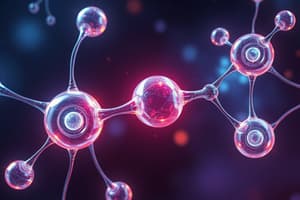Podcast
Questions and Answers
In what way does the photoelectric effect support the particle theory of light?
In what way does the photoelectric effect support the particle theory of light?
In order for an electron to be ejected from a metal surface, the electron must be struck by a single photon with at least the minimum energy needed to knock the electron loose.
What is the difference between the ground state and the excited state of an atom?
What is the difference between the ground state and the excited state of an atom?
The ground state is the lowest energy state of the atom. When the atom absorbs energy, it can move to a higher energy state, or excited state.
Under what circumstances can an atom emit a photon?
Under what circumstances can an atom emit a photon?
A photon is emitted when an atom moves from an excited state to its ground state or to a lower-energy excited state.
How can the energy levels of the atom be determined by measuring the light emitted from an atom?
How can the energy levels of the atom be determined by measuring the light emitted from an atom?
Why does electromagnetic radiation in the ultraviolet region represent a larger energy transition than does radiation in the infrared region?
Why does electromagnetic radiation in the ultraviolet region represent a larger energy transition than does radiation in the infrared region?
Which of the waves shown below has the higher frequency? (The scale is the same for each drawing.) Explain your answer.
Which of the waves shown below has the higher frequency? (The scale is the same for each drawing.) Explain your answer.
How many different photons were emitted when excited helium atoms fall back to their ground state?
How many different photons were emitted when excited helium atoms fall back to their ground state?
What is the frequency of the emitted light for one of the transitions?
What is the frequency of the emitted light for one of the transitions?
What is the wavelength of the photon emitted during an electronic transition?
What is the wavelength of the photon emitted during an electronic transition?
Flashcards are hidden until you start studying
Study Notes
Photoelectric Effect
- Supports the particle theory of light; electrons are ejected from metal surfaces only when struck by a single photon of sufficient energy.
Ground State vs Excited State
- Ground state: lowest energy configuration of an atom.
- Excited state: higher energy state attained through energy absorption.
Photon Emission
- Atoms emit photons when transitioning from an excited state to the ground state or to a lower energy excited state.
Determining Energy Levels
- Energy loss during transitions results in photon emission; frequency recorded in an element's line-emission spectrum.
- Energy can be calculated using E = hv, indicating energy levels of the atom for each element.
Electromagnetic Radiation
- Ultraviolet radiation signifies larger energy transitions compared to infrared radiation due to its higher frequency and corresponding energy levels.
Wave Frequency
- Wavelength and frequency are inversely related; shorter wavelengths equate to higher frequencies.
- Wave B demonstrates a higher frequency when compared to another wave.
Helium Emission Spectrum
- Six distinct photons are emitted when an excited helium atom returns to its ground or lower energy states, indicated by six lines in the line-emission spectrum.
Energy and Frequency
- A frequency of 9.7 x 10^14 Hz corresponds to a certain energy level transition of an atom.
Wavelength Measurement
- A wavelength of 9.4 x 10^9 m indicates a specific energy transition within the electromagnetic spectrum.
Studying That Suits You
Use AI to generate personalized quizzes and flashcards to suit your learning preferences.




